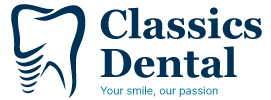Dental Hygiene
Dental hygiene treatment is a preventive dental procedure performed by a dental hygienist or dentist.
It focuses on removing plaque, tartar, and stains from the teeth, as well as promoting overall oral health. Here’s a brief summary of dental hygiene treatment:
- Gum Health Evaluation: Throughout the treatment, the hygienist evaluates the health of the gums and checks for signs of gum disease, such as redness, swelling, or bleeding. They may measure the depth of gum pockets using a periodontal probe.
- Scaling: The hygienist uses specialized instruments to remove plaque and tartar (hardened plaque) from the surfaces of the teeth, both above and below the gumline. This process is called scaling and helps prevent gum disease and tooth decay.
- Polishing: After scaling, the hygienist uses a polishing tool with a gritty paste to gently polish the teeth. This helps remove surface stains and makes the teeth smooth, making it harder for plaque and bacteria to adhere.
- Oral Hygiene Education: During the treatment, the hygienist educates the patient about proper oral hygiene practices, including brushing techniques, flossing methods, and the use of additional oral care aids like mouthwash or interdental brushes. They may also provide personalized tips based on the patient’s specific needs.
- Dental hygiene treatment is typically recommended every six months as part of routine dental care. However, the frequency may vary depending on the individual’s oral health needs and any underlying conditions. Regular dental hygiene treatments help maintain optimal oral health, prevent dental problems, and contribute to a healthy smile.
It focuses on removing plaque, tartar, and stains from the teeth, as well as promoting overall oral health. Here’s a brief summary of dental hygiene treatment:
- Gum Health Evaluation: Throughout the treatment, the hygienist evaluates the health of the gums and checks for signs of gum disease, such as redness, swelling, or bleeding. They may measure the depth of gum pockets using a periodontal probe.
- Scaling: The hygienist uses specialized instruments to remove plaque and tartar (hardened plaque) from the surfaces of the teeth, both above and below the gumline. This process is called scaling and helps prevent gum disease and tooth decay.
- Polishing: After scaling, the hygienist uses a polishing tool with a gritty paste to gently polish the teeth. This helps remove surface stains and makes the teeth smooth, making it harder for plaque and bacteria to adhere.
- Oral Hygiene Education: During the treatment, the hygienist educates the patient about proper oral hygiene practices, including brushing techniques, flossing methods, and the use of additional oral care aids like mouthwash or interdental brushes. They may also provide personalized tips based on the patient’s specific needs.
- Dental hygiene treatment is typically recommended every six months as part of routine dental care. However, the frequency may vary depending on the individual’s oral health needs and any underlying conditions. Regular dental hygiene treatments help maintain optimal oral health, prevent dental problems, and contribute to a healthy smile.
For all your dental needs, call 0800 454 535
